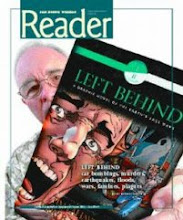Why We Can’t Think AnymoreThe
crisis of thinking begins with a crisis in reading--in particular
reading long, thoughtful pieces that put demands on the mind. This is
not a new idea, but every year it’s an increasingly disturbing reality:
Nicholas Carr's 2010 book,
The Shallows,
begins with the author's irritation at his own truncated attention span
for reading. Something neurophysiological is happening to us, he
argued, and we don't know what it is. That must be the case, because if
there is any law of neurophysiology, it is that the brain wires itself
continuously in accordance with its every experience. A decade later,
Carr's discomfort is shared by growing legions of frustrated, formerly
serious readers.
So writes Adam Garfinkle in
“The Erosion of Deep Thought" in
National Affairs. Perhaps
to prove his point, he wrote a long, deep article to test how many
would finish it. I didn’t, even though I found it pretty interesting.
Perhaps I’m one of the growing legions of frustrated, formerly serious
readers. Or maybe he just needed an editor. Still worth reading--most
of it anyway.
Almost
as soon as the shaking stopped, city officials began worrying about how
the populace would respond. With every shop window broken, would
looters ransack the local merchants? Would citizens panic at the sight
of the dead or wounded? …
The
Anchorage officials weren’t being unusually paranoid. At the time, most
experts believed any major disaster would cause “a mass outbreak of
hysterical neurosis among the civilian population,” as social scientist
Richard M. Titmuss had put it some years earlier. Shocked by carnage and
desperate for food and shelter, people would “behave like frightened
and unsatisfied children.” Only firm control by powerful authorities
could keep the lid on such dangerous situations….
Anchorage quickly became a kind of open-air laboratory for testing this public-panic hypothesis.
If you don’t have time for all three articles, do read the Alaska story. It’s humankind at its best.
Two Takes on the AscensionChrist’s
ascension is remembered this week in the more liturgical traditions.
Naturally, it’s common for all Christians to celebrate Christ’s death
and resurrection, but the ascension, not so much. Yet it is an event
rich in theology. Here is
a distinctly Protestant take, with its emphasis on personal confession of sin. And then there is
a distinctly Catholic take, more communal and cosmic in scope.
That’s Really WeirdI’ve
been noting some of the mysteries we face into right now, here’s
another: coincidences. Some are quite amazing, and do leave one in a
state of wonder, as
this video notes.
Grace and peace,
























No comments:
Post a Comment